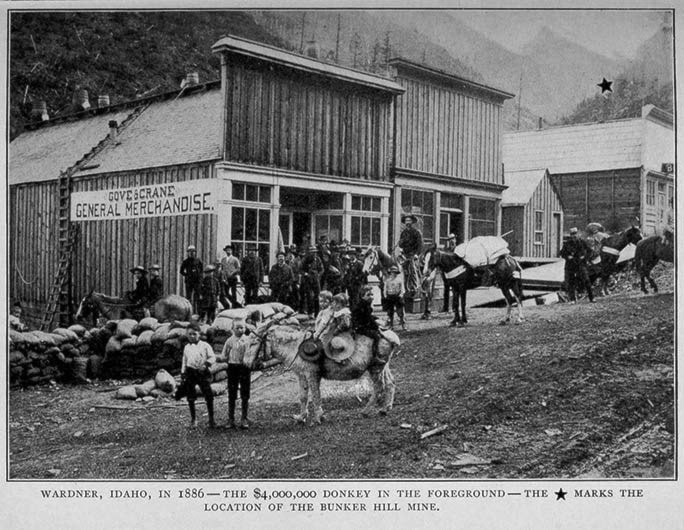Jim Cameron
Jim Wardner's handbills circulating on the streets of St. Louis went straight to the point: "MONEY FOR ALL! Come to the
National Candy Bank this evening in the Laclede Hotel. 5000 lbs. Granulated Sugar to be sold at 5 cents per pound."
The thing was, sugar was selling for 10 cents per pound at the time. A temporary "bank" in a hotel storefront, a counter, a few banners and a whole lot of sugar brought people in droves. Jim made money by selling highly overpriced sticks of candy wrapped in a coupon allowing the purchase of up to fifty pounds of sugar at half price. His calculations proved correct and the money started to pour in, until those in power began demanding serious monetary kickbacks; time to pull up and move out, $1,700 dollars to the good. It was all in a day's work for Jim Wardner; mining and real estate magnate, entrepreneur, raconteur and occasional showman. From St. Louis to Deadwood to New Orleans, Jim spent the next few years making and losing money through numerous means. In 1883, he joined the gold rush to the Couer d'Alene area, specifically the booming mining camps of Murray and Eagle City, where he undertook a very successful stint of building miles of ditches to carry water to the miners. Jim was doing very well but a chance meeting with a colleague in 1885 led Jim to a spanking new "find." Following his friend's directions, Jim travelled miles through the bush to the camp of Noah Kellogg, Con Sullivan and Phil O'Rourke, all hardened prospectors. It seems that a short time previously they made their evening camp near the mouth of a creek some distance away. When they awoke the next morning their jackass, a "diminutive but very cunning and tricky animal," had wandered off. The trail led a merry chase to a canyon whereupon they found the donkey staring intently at a point in the distance where the sun's rays reflected a most impressive chute of galena ore. The donkey had discovered what was to become the Bunker Hill and Sullivan Mines, two of the highest paying propositions in the history of the Northwest. Having informed Jim of the situation while happily imbibing of his whiskey, the miners soon went about their work whilst Jim slipped out of camp and staked the water rights for the entire area, a task the boys had overlooked. The miners took his claim with good grace and formed an agreement that made them all – including grubstakers Peck and Cooper, the actual absentee owners of the jackass – wealthy men. Mining communities immediately sprang up throughout the area including Wardner, Idaho, where Jim and his partner Horace Davenport literally cornered the market by buying all the corner lots in the new community and re-selling them at a hefty profit. The town gradually died as the mining wore down but, by then, Jim had moved on to the west coast. There, on behalf of millionaire Nelson Bennett, he did much to create the town of Fairhaven. He organized the Water Works, the Electric Light Co., the Samish Lake Logging & Milling Co. (of which he was president) and the first National Bank (vice-president). He built an expensively expansive residence referred to as "Wardner's Castle." which still stands today in Fairhaven, now an historic section of Bellingham, Washington.
In 1888, Jim, with time on his hands, announced the formation of the Consolidated Black Cat Co. Ltd and the purchase of a small island in Puget Sound stating he planned to raise black cats for the purpose of skinning them in order to supply a demand in certain parts of Missouri and Arkansas. According to Jim, the hide of a black cat killed in the dark of the moon was much valued for medical reasons. As far-fetched as it sounded, the news travelled far and wide, published in varying accounts in major papers throughout the land. It created quite a stir at the time and gave Jim much amusement and one more story to add to his repertoire, a tale that remains an urban legend to the present day.
With his family ensconced in Fairhaven, he continued his rambling ways, buying and selling real estate in Kaslo, B.C., in 1892, and then travelling to Cape Town, South Africa where he remained for three years. Returning to Canada in 1895, he brokered the purchase of 842 lots for $176,000 in the new settlement of Rossland, B.C. and then anticipated the coming of the CPR to the East Kootenay by buying a great deal of land near the Kootenay River which he promptly named Wardner, B.C. The town went through a rapid boom period in 1897, when it was thought that the CPR would make its main depot there, but gradually died out when Cranbrook became the destination of choice. By then, having lost two large, heavily laden riverboats which sank in the Kootenay River on the same day at a significant financial loss, Jim Wardner was in Dawson City attending to the Yukon gold rush as a merchant and mining speculator.
It was in Mexico that Jim's luck finally went bust. While in Sonora, working on behalf of a group of British Columbia businessmen, he contracted an illness. Trapped due to an uprising by the local Yaqui Indians he was unable to seek medical help. When he finally attempted the journey back to British Columbia he only made it as far as El Paso, Texas where, having lived more lives than a clowder of black cats, he died on Mar. 3, 1905, age 59. The Cranbrook Herald stated: "Jim Wardner is dead but if there is any reward in the future for a good heart, good intentions, good acts and a charitable soul, Jim Wardner will reap that reward."
